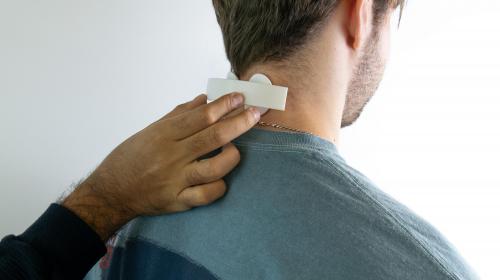How to self-certify your products
When discussing certification there are two questions that arise; ‘should I self-certify my device?’ and if so, ‘where do I start?’ The answer to the first question is simple; you can, but (like many elements of product development) it depends. This response can also make the second question seem rather daunting. IDC has a wealth of experience designing products for CE and UKCA marking and are well versed in the testing requirements and standards that must be met. Whether it is a medical device or consumer good, there are some good practices to adopt that can make the self-certification process much less intimidating.

When placing any new product on the British or European market it is essential that the device is safe. In Europe this certification of safety is evidenced by the letters ‘CE’; and in Britain this is being superseded by the four letter acronym ‘UKCA’. Having these markings on a product signifies that it has been assessed and meets the safety, health and environmental requirements set out in the relevant directive and standards.
Understand the Standards First – Standards Drive Everything
The place most people will start when certifying a product is the Directive or UK equivalent regulation. These documents comprise a long list of generalised, top level statements that outline the legislation relevant to a broad category of products. Whilst these can be a good starting point and are important to have an awareness of, this is not where the meat of your requirements are found. It is only when you identify the standards that are relevant to your product that you begin to understand the test requirements for your device and key design constraints you may have to adhere to.

Read through and understand everything that will/could apply to your product in the standards. Pay attention to the text/definitions. Whilst it may seem a laborious process initially, it will save you significant cost further down the track…For example, if re-work is required to pass a test that was brushed over initially; or corners end up being cut if you get too far down the track before realising your device has to display some information at a specified size etc. Early identification and awareness of all these elements is crucial to delivering a product that conforms to the CE/UKCA requirements, as well as ensuring the product is delivered on time and on budget.
Adopt a Practical Approach…Clearly define your Product and what applies to it
Whilst the standards do go into detail on the requirements for each test, remember that they still apply to a large number of products that fall under their title. Be practical in your approach and understand that not every test or restriction will apply to your device. Provided you can clearly justify why a particular test may not be relevant to your device, then there is no need to carry out every single test. The crucial part of this is justification; there should be no ambiguity in your argument.
Document everything from the start
It may seem trivial, but do not underestimate the amount of material you will have to keep track of and crucially, do not leave documentation to the last minute. The list below is very much a top level checklist of the key documents that have to be provided for a Technical File. Within each of these elements, depending on the complexity of your product, there will likely be a huge number of reports and documents to deliver. The amount of documentation increases further still for medical devices. Moreover, as you progress and dive deeper into any project, it is well known that early elements can become an increasingly distant memory…so the idea that ‘I’ll just go back and document that later’ can be very dangerous. Keeping a live and up to date record of things as they happen can be gold dust when creating some of the CE/UKCA specific reports.
- Certificates of Conformity (CoC)
- Serial Number Logs
- Test protocols and reports
- Testing Requirements Checklist (justify every element of what does/doesn’t apply)
- Declaration of Conformity
- Manufacturing Data Pack (Eng. Drawings, BOM, Part Files etc.)
- Assembly Procedure and Checklist
- Instructions for Use (IFU)
- Design Reviews and Electronic/Software Reviews
- Risk Assessment

UKCA vs CE
As of 1st January 2021 UKCA marking will replace CE marking for goods being placed on the GB market. Broadly speaking the requirements for two marks are the same, the difference is that the requirements for UKCA marking are taken from GB and ISO standards as opposed to EN standards; but again these standards are near identical and typically if you conform to one you will conform to the other. The key thing to be aware of is that if you want to place a product on both markets, you will require both markings. Crucially, if you are a GB manufacturer and want to place a product on the EU market with a CE marking, you will require an authorised European representative. The responsibilities of the manufacturer and authorised representative are outlined in the directive, and acting as an authorised representative for manufacturers based outside the EU requires legal, technical and regulatory due diligence. Furthermore, the contact details for this representative will need to be placed on the device labels, packaging and IFU, so it is crucial to have this agreement arranged before even considering certifying a product with a CE mark.

Should I outsource certification? Hopefully, having read this far, you are beginning to see that the answer to this question is definitely not ‘I must outsource this’. Companies who offer a full certification service will encourage you to think otherwise. That is not to say these services should not be used, it can certainly be cost effective in some cases. However, do not jump the gun; before deciding to use these services, ensure you have a thorough understanding of the relevant standards. In doing so, it quickly becomes apparent that a number of safety testing elements can be conducted in house.
Nevertheless, there are complexities inherent in many products that will require tests that are beyond your capabilities. Further to this, there may be pieces of equipment required for some tests that are incredibly expensive and do not make financial sense to purchase for a single use. This is where it is absolutely worth outsourcing. Most test houses will offer a tailored service and by having an awareness of what tests are required and the equipment that is needed, you can save significant costs for yourself and the test house.

Useful Templates to Establish
- Serial Number Logs
- Test protocols and reports
- Testing Requirements Checklist – make editable for different standards
- Design Reviews
- Electronic/Software Reviews
About the author
Archie Ashford is a Graduate Industrial Designer at IDC. Archie has been heavily involved in understanding requirements for CE and UKCA marking of medical and industrial projects at IDC. Archie has recently been involved in all elements of delivering a UKCA and CE certified device; from designing products to pass all testing elements to creating and collating the documentation necessary for technical files.

Sign up for our top resources and articles on product development.


